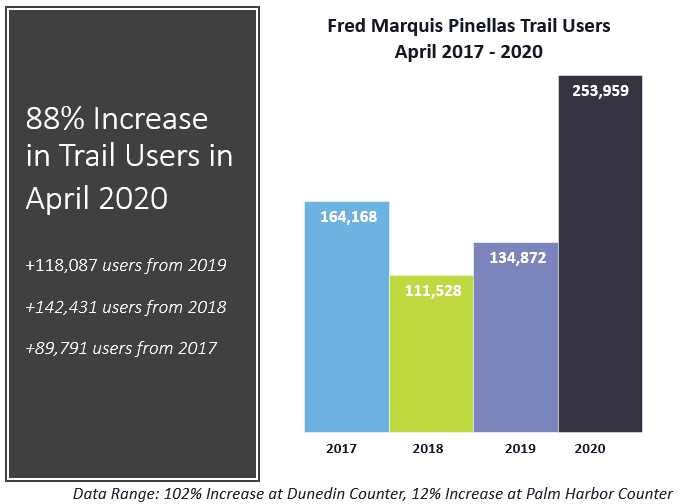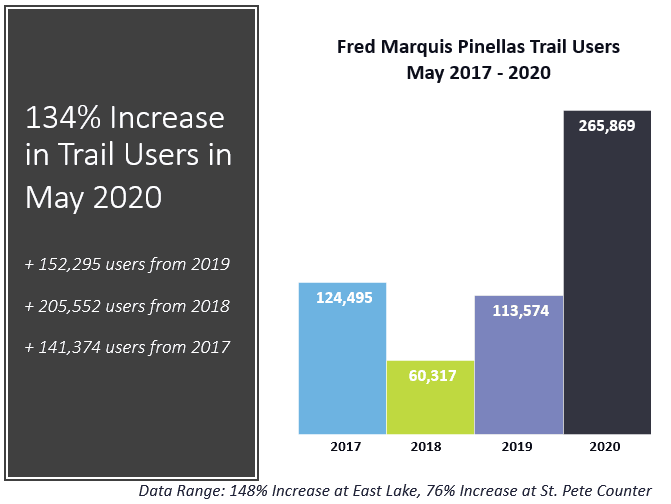Epidemic Event Shapes Community Transportation Notions
Extreme events have evolved within the last several months as COVID-19 rattled the world with its unparallel imprint. Forward Pinellas staff expresses sincere sympathy to the individuals and families affected by the devastating tragedies across the globe and here in Pinellas County. In our role planning for transportation and land development countywide, we are examining the data, trends and community responses to the COVID-19 pandemic, and what they may mean as we address transportation needs in the future.
Fewer Cars, Fewer Crashes
At Forward Pinellas, we collect a wide variety of transportation data as part of our commitment to safety and to assist with developing transportation plans. Comparing data from March and April to the same period last year provides staggering results. In the Tampa Bay area, major roadways experienced a roughly 30-50 percent decrease in daily, vehicular traffic volumes. In addition, Pinellas County saw a 38 percent decrease in total vehicle crashes in March and over 100 percent decrease in April compared to the prior year. Also, there was an 85 percent decrease in fatalities in March and a 50 percent decrease in April.

Close examination of this data also shows some interesting results, including a 30 percent decrease in injuries and a 13 percent reduction in crashes from aggressive drivers. Conversely, there was a three percent increase in crashes involving intoxication and a similar increase in crashes where a driver did not stop at a stop sign or traffic signal.
While we have seen a large increase in people on bikes and walking on the trails in March and April, there has not been a corresponding increase in non-motorized crashes. Instead, we have seen large decreases in the number of crashes involving bicyclists and pedestrians. One possibility for that trend may be that with fewer cars on the road and more cyclists and pedestrians using the trails, there is less conflict with motor vehicles on major roadways, which are typically designed to move cars quickly and not with the safety of other users in mind.
Temporary Transit Decline?

So, what about transit? The value and importance of transit as a component of the transportation network should not be underestimated in Pinellas County. Moving people from place to place safely, efficiently and economically has been the goal of the Pinellas Suncoast Transit Authority (PSTA) for decades. The nationally recognized “Gold Standard” transit service, awarded from the U.S. Department of Homeland Security’s Transportation Security Administration in 2011, demonstrated a 50 percent decline in ridership this year in March and April compared to 2019. Proactive measures taken by PSTA to provide free fares, encourage the use of face masks, reduce the capacity of buses to ten people per bus, and require passengers to use the rear entrance (unless a wheelchair passenger cannot use the rear door) for boarding, significantly improve the ability to allow those who depend on bus service to continue moving safely from place to place during the pandemic. PSTA has strategically reduced select routes to provide safe service and is continuing to monitor ridership closely to ensure service is provided when and where people need it most. As people are now going back to work, PSTA is adding back more routes in early June. Time will tell how long ridership will be down, but as economic and public health conditions improve, it is expected that people will return to previous usage of PSTA service.
The “Trail” to health and wellness during COVID-19
One promising shift demonstrated in Marchand April is the increase in cyclist and pedestrian traffic. Forward Pinellas’ data from permanent count stations showed more than 265,000 trail users, a 134 percent increase in cyclists, runners, walkers and skaters during the month of May, an 88 percent increase in April with 250,000 trail users, and a 35 percent increase in March when compared to previous years data. These data are collected from eight electromagnetic trail counters located along the Fred Marquis Pinellas Trail. Our data shows a slight increase in cyclists versus pedestrians, and a slight increase in weekday users versus weekend users when measured against previous years’ data. Coast Bike Share in the City of St. Pete also reported an increase in March and April in ridership and an increase in length of rides.



As people choose trails for recreation, physical exercise and commuting, the bicycle is finally getting its day to shine. Around Pinellas County, bike shops are running short on supplies as the demand for bike purchases and rentals has drastically spiked. An article written by The Guardian reports that the cycling boom has resulted in bike shops experiencing huge demand with customers “unearthing old bikes from their long-time hibernation in a garage or loft and bringing them in for repair.” From a public health perspective, these are positive changes as an increase in outdoor exercise provides both physical and mental wellness benefits. Sustainability efforts are also seeing improvements as increased use of trails and reduced use of cars is an important step to reducing our carbon footprint.
However, an increase in trail use also highlights challenges. As Pinellas County is the state’s most densely populated county, increased density on trails speaks to the need for expansion of the existing 2,047-mile network of bicycle lanes, shared-use paths/trails, and sidewalks in Pinellas County. Our long-range plans provide the framework to expand this network. Although there has been impressive work within the county over the last 30 years, opportunities abound to expand on the existing network using funding from the Complete Streets grant program, the Transportation Alternatives grant program, and other funding opportunities for roadways identified during the development of the Transportation Improvement Program. An increase in trail use also speaks to the importance of social distancing during COVID-19. We have provided safety tips for trail users in our Bike Savvy, Stay Happy blog which help us all stay safe while enjoying the outdoors.
Drastic Flight Cancellations
From the roads and trails to air travel, transportation trends continue to be shaped by the pandemic. Tampa International Airport (TPA) reported to Forward Pinellas staff staggering figures on flights in March and April. Specifically, TPA reported 2,348 flight cancellations in March and 4,219 flight cancellations in April (incoming and outgoing flights).

The St. Pete-Clearwater Airport reported a 97 percent loss in passenger traffic. This reduction in air travel is one of the contributing factors to consider when analyzing the lower traffic rates in the region, given the high numbers of incoming tourists that we typically see this time of year.
Economic Impacts Begin
A data analytics company, Smith Travel Resources (STR), report showed the Tampa Bay area was among the top ten for markets affected earliest from the pandemic. An almost 62 percent reduction in revenue for hotels in Tampa/St. Petersburg was reported by STR for March. The lower number of tourists in the Tampa Bay area may have resulted in less traffic but the impact to the economy and the tourism industry from the pandemic will have lingering effects throughout our communities even after tourism rebounds. Public officials are now strategizing and analyzing these impacts to provide solutions to boost the economy.
Parking fees may not be the first economic impact many of us consider when thinking about loss of city revenue. However, TBN Weekly reported Treasure Island collected only $3,400 of revenue in April this year when last year they reported $102,400 in revenue in the same month. Many communities across Pinellas County rely on this source of revenue and are already considering options to offset this revenue loss. It is clear the cumulative effects from the pandemic are just starting to be understood and how these changes impact our daily lives, and parking options, will be realized soon.
Beyond job losses, changes in travel are having major effects in different ways. The Orlando Sentinel reported the State of Florida experienced a $775 million loss in sales, fuel and other tax revenues in March. The economic recovery process may require deep cuts in the transportation work program, deferring needed projects for several years.
Changes May Bring New Challenges and New Opportunities

Many challenges to the transportation system existed prior to the COVID-19 epidemic; and post-epidemic there is an opportunity for change. Current obstacles to transportation projects include budgeting, infrastructure, and safety, as well as balancing public and private needs. Post COVID-19, will more of us use bikes to commute, work from home, or travel less? If so, what will be the effects on traffic congestion and safety? We have an opportunity to redefine our transportation options through a lens of public health. COVID-19 has initiated a refocus for our communities centered around safety and wellness. We can all take steps to consider the safety of others and find opportunities to improve our own health post-pandemic. These steps include being safe and alert while operating motor vehicles, biking and walking more, and prioritizing a sustainable infrastructure to assist with demands of the future and economic growth.








